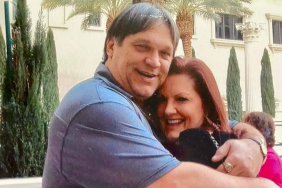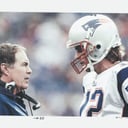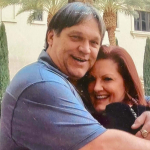ROSEVILLE, Calif. – There is only a smattering of baseball memorabilia on display in Steve Sax’s home office, a show of restraint considering he was a five-time All-Star.
His Rookie of the Year trophy is nowhere to be found. There is no Silver Slugger Award on a shelf. Neither World Series ring resides on a finger.
Advertisement
Instead, Sax’s most cherished possessions abound just out of sight. And on a rainy afternoon in this Sacramento suburb, he is in a nostalgic mood.
“Oh, I wanted to show you something,’’ Sax said.
The Los Angeles Dodgers sparkplug rises from behind his desk and returns with a treasure. He lifts a delicate glass cover to unveil one of his favorite art pieces.
It’s a misshapen model airplane with all the hallmarks of a grade-school project. The lumpy black body is made of clay. Two red marbles serve as the jet’s afterburners while one green one represents the landing gear.
“So, he made that for me,’’ Sax, 64, said. “He was in the fourth or fifth grade. And he said, ‘Dad, I’m gonna be an aviator someday.’’’
John was 8 years old when a friend of the family, a former Navy pilot, took him up in a single-engine, single-seat World War II Soviet fighter called the Yakovlev Yak. They tooled around skyways above Northwest Oregon and for John, it was love at first flight. After that, the only place he wanted to be was in the sky.
Rich Ward, the pilot that day, had seen this phenomenon before. “There are some unusual people where you take them up one time and it’s over,” he said by phone. “Flying is what they’re going to do. I think they were reincarnated: they used to be birds.”
John Sax was so obsessed with flying that other youthful pursuits, such as baseball, barely registered. A ball once sailed over John’s head as if undetected during a Little League game. Oddly, the kid looked skyward the whole time but never budged.
More baffled than angry, Sax asked little Johnny after the game why he didn’t, you know, try to catch it.
“I saw the ball,’’ the kid protested, “but, Dad, did you see the C-130 going by? Each one of those engines costs 7 million dollars!”
Sax, a second baseman who played for the Yankees, White Sox and A’s as well as the Dodgers in a 14-year major league career, laughed as he recounted that story. Soon he was out of his seat again, this time reaching into a display case. He pulled down a poem encased in a silver frame.
Advertisement
It’s called “My Dad: by John Sax.” The outdated font suggests it rolled out of a home printer in the early 1990s. It reads, in part:
My dad was with me
when I was born
I know he’ll be beside me
through every storm
“Johnny wrote that for me when he was a little boy,’’ Sax said. “He won first prize in a contest.”
Another item in Sax’s collection, however, remained undisturbed. He does not rise to get it. He merely glowers in the direction of an adjoining room, where an autopsy report sits banished to a drawer for eternity.
“I haven’t looked at it. I can’t look at it,’’ Sax said. “And that’s forever. I just don’t want to see it.”
John became an aviator, just as he told his dad he would. He was a star pilot in the military, tapped for the Marine Corps version of “Top Gun” and heralded by his commanding officer as “a natural in the cockpit, just leaps and bounds above his peers in terms of his progression.”
Capt John J. Sax died with four other Marines when the aircraft he was co-piloting malfunctioned and crashed into a remote Southern California desert on June 8, 2022.
The reason Steve Sax has now parted with so many of his baseball treasures is that he had dreamed of one day giving them to his son. Instead, he holds tight only to all the gifts John gave him.
“He was my hero,’’ Sax said.
That is why Sax is here now, alternating between tears and laughter, between happy memories and debilitating grief, as he embarks on his mission to honor John’s life.

If the military operated like the major leagues, John Sax might have won Rookie of the Year, too.
“He walked into the room and was just larger than life,’’ Lt. Col. John Miller recalled by phone. “I see a lot of Marine officers check in. He was just different right from the get-go. His personality, his ability to communicate, his motivation, his excitement – full of energy.”
Advertisement
Miller serves as the commanding officer for the “Purple Foxes,” a squadron based at the Marine Corps Air Station Camp Pendleton (San Diego County).
The unit’s colorful history dates back to the Vietnam War when, Miller said, an infantry battalion was under heavy fire during the battle for Khe Sanh in 1968 and needed an emergency resupply. The Purple Foxes heard the distress calls and immediately launched, resupplying the Marines and prompting one of the grateful men to reply: “You were the only ones that gave a s— about us.”
The line became an enduring motto. “Give a s—” lives on in the Purple Foxes culture. It’s painted onto aircraft and imprinted on shoulder patches.
It was in this rough-and-tumble culture that John Sax, the failed Little League outfielder, became a franchise player. He was especially adept at maneuvering the MV-22B Osprey, an aircraft that combines the agility of a helicopter with the speed of a turboprop. The Marines use the Osprey as an assault support aircraft.
It was John Sax’s favorite mode of travel.
“He loved it,’’ Miller said. “It was designed to take off and land like a helicopter, so you don’t really need a runway, but to fly in airplane mode at higher altitudes and much faster air speeds than a typical helicopter.”
Flying in the military had long been John’s goal, but it took a while for Uncle Sam to welcome him aboard. The Navy rejected John because of a shattered elbow suffered during a skimboarding accident (Dr. Neal ElAttrache, the famed Dodgers surgeon, handled the repairs.) John was later derailed by astigmatism, which also required surgery.
But John never considered a Plan B.
“Whatever it took, it didn’t matter,’’ Steve said. “It was amazing to me how driven he just was, even as a young boy. Nothing was going to get in his way. Nothing.”
Advertisement
Along the way, John earned a degree in aeronautical science at Embry-Riddle and amassed flying experience. Once he had the hang of things, he even took his mom for a spin. Debbie and Steve split when John was young, but they remain on good terms. They have an older daughter, Lauren Ashley, who is 37.
John took Debbie up in 2015 in a Cessna-172, a single-engine plane known as the Skyhawk.
Once they reached cruising altitude, John turned to her and said, “Mom, do you want to see what I’ve learned?” She was thrown by the question. They were already flying. This was what he’d learned, right?
Then her John stalled the plane, nose-dived for a spell and calmly pulled out of the stall. “Then he looks over at me and he goes, ‘Don’t tell my instructor I just did that,’” Debbie said with a laugh.

Steve Sax had a much different relationship with his own father. John Thomas Sax was a Montana-born truck driver who lived life as if on a word count. He didn’t say much of anything. Specific phrases such as “I’m sorry” or “I love you” never escaped his larynx.
“He was like John Wayne,” Sax said. “My dad was not a talker. He was a doer.”
But his dad’s no-nonsense gruffness pulled Sax from the abyss during the lowest point of his career. In 1983, the infielder suddenly found himself incapable of making routine throws to first base. His version of the baseball yips became so bad that it’s now known as “Steve Sax Syndrome.” He made 30 errors that season, and his throws were so wildly errant that some smart-aleck fans along the first-base line at Dodger Stadium started wearing helmets.
“I had 26 errors at the break,’’ Sax recalled. “People make that in a career. I had 26 at the break.”
Less remembered is that Sax worked his way out of it. He overcame his throwing woes and finished in the National League’s top five for fielding percentage every year from 1986-1988, then led the American League in ’89 with the Yankees.
Advertisement
“I did! Thank you for remembering!’’ Sax said, laughing. “But I was going to tell you anyway.”
What was the cure for Steve Sax Syndrome? His stern father, John, told Steve that the only escape was to get his confidence back, and the only way to do that was to practice manically until he felt like himself again.
Then, in a rare moment of vulnerability for John Sax, he confided to Steve that he had the exact same issue as a young player, and that’s how he got out of it once upon a time.
“So I thought, ‘Wow! If Dad can go through this, then, of course, it will work,’’ Sax said. “So I took his advice, went through practice and got my confidence back one day at a time. Eventually, I took that confidence into the game – and the thing was gone.”
That tough-love lesson was the last conversation Sax ever had with his father. John died on June 10, 1983 at age 47.
It was several more years before Steve learned, to his delight, that Dad had conned him. Steve was reminiscing with his mom, Nancy, about how Dad’s willingness to open up about his throwing struggles saved his career. “And my mom whispers, ‘Your dad never had a throwing problem,’’’ Sax said.
He smiled. His parents had known each other since the fifth grade.
“He just told me that because he knew how much I revered his power and strength. And I got over it because I thought, ‘Well if he went through it …’ But he never went through it!”
The rest of Sax’s career was more fun, especially in 1988. He kicked off that magical year by belting a homer as the Dodgers’ first batter of the season. And by October, he was in the on-deck circle for Kirk Gibson’s classic home run against the A’s Dennis Eckersley in Game 1 of the World Series.
Lesser remembered, except for in this room, is that the biggest highlight for Sax that season happened in that sweet spot between Opening Day and the Fall Classic.
On Aug. 15 of that year, John Sax was born.

On the worst day of their lives, the news came in ominous trickles.
Lauren invited her mom and dad over for dinner. Debbie got there first, just in time to read a text from Rich Ward, the family friend who had taken John on that life-changing flight. The message was something about a military mishap at Camp Pendleton.
Advertisement
“He didn’t say crash,” Debbie said. ‘He said, ‘There was an incident with an Osprey.’”
Debbie called John’s cellphone and it went straight to voicemail. She checked with John’s wife, Amber, who hadn’t heard from him. Rich told them not to worry about the silence, noting that the military often goes into a communication lockdown if something goes haywire.
Debbie wasn’t yet worried, though by the time Steve’s car rolled up to the house, she at least fretted over the rest of the squadron. Steve was also unfazed; military pilots are hardly the most reachable people. Unreturned phone calls and texts were the norm.
He recalls going to bed at 9 p.m. Ten minutes later he heard a knock at the door.
There was a Marine in full dress on his doorstep.
“I knew right away,’’ Sax said.
Recounting this part of the story, Sax went quiet for several moments. This is the pattern. When talking about the crash, Sax’s words often trailed off. He would start sentences with a full head of steam before running into a wall of grief.
Then, after a few beats of silence, he would push through. He did not fight tears; he embraced them. Among the few worthwhile condolences Sax received after the accident was when a nun told him: “Grief is the price you pay for loving someone.’’’
It took a full military investigation over the next 10 months, but the family got a full accounting of what happened that day. Capt. John Sax and four other Marines were returning from a training mission at low altitude on a clear and sunny afternoon. John had a lunch date scheduled with his wife within the hour. He and Amber had a 2-year-old daughter, and a second child would be born on Sept. 22.
What happened next would later be categorized as “a catastrophic mechanical failure.” The Osprey suffered “a hard clutch engagement,’’ which is when the clutch that connects the Osprey’s rotor gearbox to its engine slips. As detailed by the Defense News, the Osprey should immediately transfer the power load from the damaged engine to a second operational one. In this case, though, the power transfer blew out that engine, too. There is no third engine.
Advertisement
“It fell,” Steve Sax said, “like a rock out of the sky.” He even knows the moment of impact, 12:14 p.m. “and 18 seconds.”
The four other service members who perished that day were Cpl. Nathan E. Carlson, 21, of Winnebago, Ill.; Capt. Nicholas P. Losapio, 31, of Rockingham, N.H.; Cpl. Seth D. Rasmuson, 21, of Johnson, Wyo.; and Lance Cpl. Evan A. Strickland, 19, of Valencia, N.M.
The official report following the military investigation stated, “There was nothing the crew of the SWIFT 11 could have done to anticipate or prevent this aviation mishap.”
This is one of the calamities that put John Sax’s favorite aircraft under increased scrutiny. From March 2022 to November 2023, 20 service members died in four fatal Osprey crashes, as noted in a recent NBC story. The U.S. military grounded its entire fleet of about 400 V-22 Ospreys after the crash of an Air Force Special Operations Command Osprey off Japan last November killed eight airmen.
In the case of the Purple Foxes, the fallen crew members remain a familiar presence at Camp Pendleton, where the new generation of Marine pilots wear patches bearing their names.
“We talk about them all the time,’’ Miller said. “When we walk into the squadron, we have a huge plaque with all their pictures above the entranceway.
“They are kind of a driving force for us to always do the right thing.”

The first fundraiser for the Capt. John J. Sax Family Foundation took place at the Ronald Reagan Presidential Library in Los Angeles on Nov. 7, 2023. More than a thousand Marines attended, according to one estimate. Miller, who was John Sax’s commanding officer and closest confidante, wrote Steve Sax a letter in the aftermath of the tragedy:
“John spoke of you often and about how great his childhood was. What is most amazing to me is that he never once mentioned that you were a professional baseball player. Humility was his most impressive character trait. He loved you, Deborah, Lauren and his family dearly. … His life and legacy are a direct testament to how you raised John and for that, you should be proud.”
Advertisement
For all of the baseball memorabilia he’s given away, there’s one notable doozy in Sax’s home office. It’s a 4-foot by 6-foot painting called “Babe and the Kids,” based on a famous 1922 photo of Babe Ruth surrounded by schoolchildren. Sports artist Opie Otterstadt reimagined the photo by painting all the “kids” as Hall of Famers. There are baby-faced versions of Roberto Clemente and Sandy Koufax and George Brett.
“I look at this painting every day,” Sax said.
Now, the image is at the heart of the biggest fundraiser to date for the nascent John J. Sax Family Foundation. Interactive digital versions of the painting are for sale, and the proceeds will fund grants for young people who dreamed, as John Sax once did, of taking flight. “Honestly, there’s no way you can ever put a lid on that much light and energy,” Debbie Sax said. “So we want to just keep it going.”
Steve Sax said the foundation has already given away $10,000 in grant money to aspiring aviators. The funding got a boost when Sax auctioned off all that hardware from his baseball career.
“It doesn’t necessarily have to be the military,’’ Sax said. “It could be somebody who wants to become an astronaut. It’s pretty broad. But if they’ve got a passion for flight, that’s what we’re gonna help them with.”
Steve Sax hopes the foundation will keep John’s memory alive. More practically, it gives him something else to hold onto, right alongside the clay fighter jet and the poem.
One of the stages of grief is acceptance, but Sax is nowhere near that territory, and finds it hard to believe such a stage exists.
“Because I just don’t understand it,” he said. “I know John’s not here. But I just …”
He hits that wall again.
“… I can’t grab it, still. You’re moving forward but you’re not moving on. … I try to think about what John would want. But the one line I heard that really summed up losing a child was: ‘The pain never goes away until you’ve taken your last breath. It won’t go away until your heart stops beating.’
“But I believe in heaven. And I believe I’ll see him again.”
(Top image: Dan Goldfarb / The Athletic; Photo: Daniel Brown / The Athletic)












